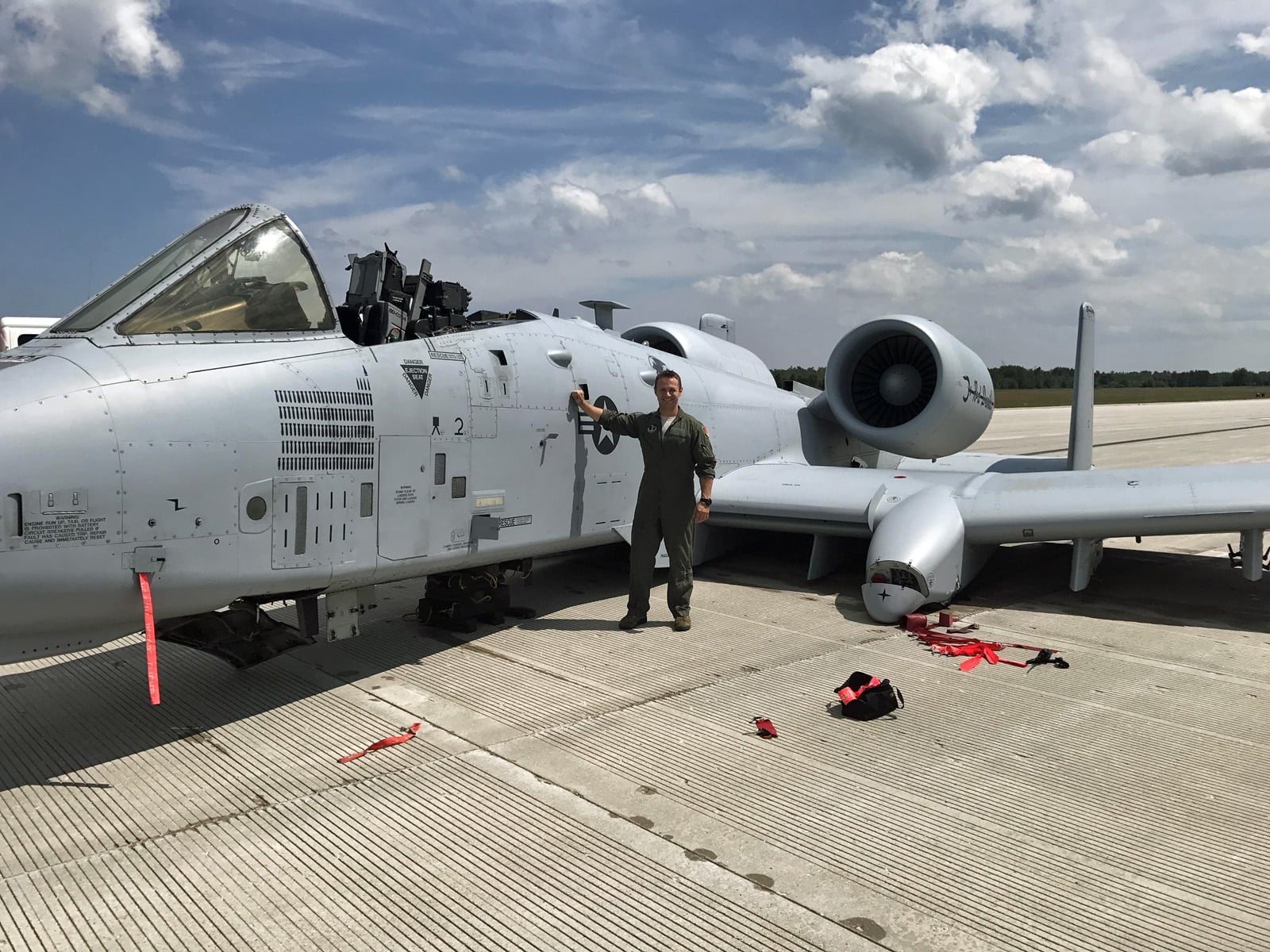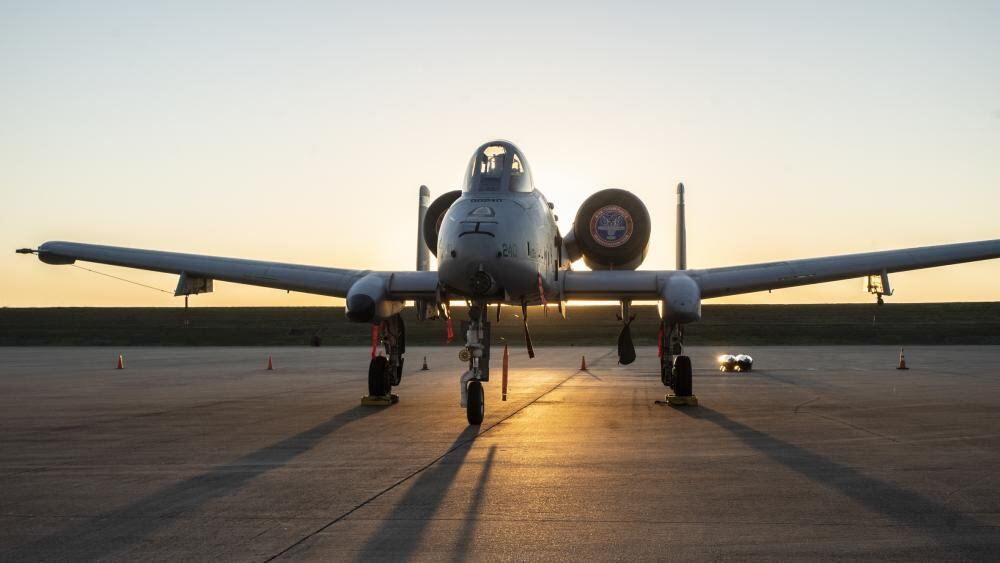An A-10 Thunderbolt II pilot at Whiteman Air Force Base, Missouri, recently pinned on the Distinguished Flying Cross for actions he took more than a decade ago during a combat search-and-rescue mission in Afghanistan.
Lt. Col. Mike Hilkert, operations director at the 303rd Fighter Squadron, received the DFC with valor on Oct. 2 through a combination of support from local leadership and a bit of retrospect. The military’s seventh-highest award honors heroism or extraordinary achievement during aerial flight, particularly in harrowing combat situations.
On April 23, 2011, Hilkert coordinated the movement of 21 aircraft in a fight lasting more than six hours, according to the 442nd Fighter Wing at Whiteman. The mission required securing two landing zones, scooping up two pararescue jumpers and a downed OH-58D Kiowa helicopter pilot, and helping 32 soldiers evacuate the area.
“He repeatedly put his aircraft in harm’s way to draw fire away from rescue helicopters and was instrumental [in] saving the lives of more than 30 soldiers and airmen,” the wing said Oct. 29.

The wing now calls it “one of the most intense combat rescue missions of the Afghanistan war.” But at the time, chaotic CSAR runs were a routine occurrence, 442nd Operations Group commander Col. Michael Leonas told Air Force Times.
Multiple airmen previously earned awards for the mission, including four Silver Stars and three Distinguished Flying Crosses with valor. Ten years on, with a refreshed award application and new slate of leaders backing him, Hilkert has joined their ranks.
“It’s bittersweet,” Hilkert said about receiving the DFC in an Oct. 28 press release. “I’m honored to be amongst a group of heroes that did their best with a bad situation. Several people lost their lives during this mission, so it wasn’t all high fives when we got home. We flew back to Kandahar in silence.”
That day in 2011, Staff Sgts. Zachary Kline and Bill Cenna responded to retrieve two Army pilots — one of whom had died — from a downed helicopter in northeast Afghanistan. After the pararescuemen dropped down to the crash site, they came under heavy fire from an unnamed enemy that prevented them from escaping and hit their two HH-60 Pave Hawk helicopters as well as an airman onboard, Tech. Sgt. Jim Davis.
The gunfire was so harsh that Kline, Cenna, the surviving pilot and a third pararescue jumper were unable to hoist themselves up into a Pave Hawk, so the helicopter lowered itself to them in a “daring one-wheel hover,” the Air Force said.
While one HH-60 was on its way back from ferrying Davis out for medical attention, the other headed to a nearby forward operating base for fuel and ammunition.
RELATED

“When they set down, however, they discovered the aircraft had been heavily damaged and had lost most of its main transmission fluid. They made the call to return to Bagram Airfield and pick up a spare Pave Hawk,” the Air Force said in the release.
As Kline and Cenna crouched behind a rock outcropping to avoid the bullets, the Kiowa helicopter they had been dispatched to burst into flames when it was hit by enemy fire.
“The two bolted toward a nearby ravine before the fire sparked off the munitions still on the helo,” the Air Force said.
The troops needed reinforcements to get to the Kiowa crash site. So they called in three A-10s, including the one flown by Hilkert, call sign “Vago,” who was watching over a ground assault force elsewhere.
The change of plans proved to be a hectic night.
“I can only imagine how ‘Vago’ must have felt after likely consuming 3,000-plus calories of seafood and beef, and then carrying 10 Rip Its in his flight suit out of the chow hall, back to the Expeditionary Fighter Squadron, and then going and flying a 10-and-a-half-hour sortie,” 442nd Operations Group deputy commander Lt. Col. Rick Mitchell, who was deployed with Hilkert, said in the release.
The other two A-10s started to search for the downed Kiowa pilot and PJs, and Hilkert worked with various air operations centers and the Joint Personnel Recovery Center to set up airspace restrictions and communications.

“About half an hour later, the enemy pinned Kline and Cenna down with renewed heavy machine gun fire at close range,” the release said. “Hilkert, while in the process of hooking up to the tanker to take on fuel, found the threat and marked the target 50 meters from the two PJs.”
Two A-10s fired back with the Warthogs’ 30mm cannons and saved Kline and Cenna’s lives, the Air Force said. But they weren’t done yet.
Later in the morning, two groups of 16 Army quick reaction force soldiers were also hit by enemy fire that killed one member and wounded others.
Hilkert peered through binoculars to keep an eye on one group and used the A-10s targeting pod for the other, while figuring out where the enemy was set up nearby.
To add to the multitasking, he updated all aircraft on their positions so AH-64D Apache helicopters could launch airstrikes without hitting other members of the U.S.-led coalition. He also called in a tanker overhead and tasked surveillance planes to search out enemy positions.
RELATED

“Meanwhile, the [Pave Hawks] and two Apaches in a four-ship rescue formation … picked up a wounded member of one of the QRFs. As they took heavy fire, they were forced time and again to pull back and reset the formation, until the Apaches destroyed the enemy position with their Hellfire missiles,” the Air Force said.
Hilkert hoped to distract the enemy from the helicopters so they could land and bring out the hurt soldier. He repeatedly flew within range of the opposing forces, trying to get them to fire their surface-to-air weapons at him instead of the rescuers.
The maneuver worked, and an HH-60 airlifted the soldier out. Rescue crews picked up Kline, Cenna and the Kiowa pilots later as well.
Hilkert continues to serve in the Air Force Reserve.
“Though he wasn’t with the [’Kansas City Hawgs’] at the time, many of our current members were deployed to Kandahar with him,” the 442nd Fighter Wing wrote on Facebook. “We’re honored to have [Reserve citizen airmen] like him serving with us today.”
Rachel Cohen is the editor of Air Force Times. She joined the publication as its senior reporter in March 2021. Her work has appeared in the Washington Post, the Frederick News-Post (Md.), Air and Space Forces Magazine, Inside Defense, Inside Health Policy and elsewhere.




